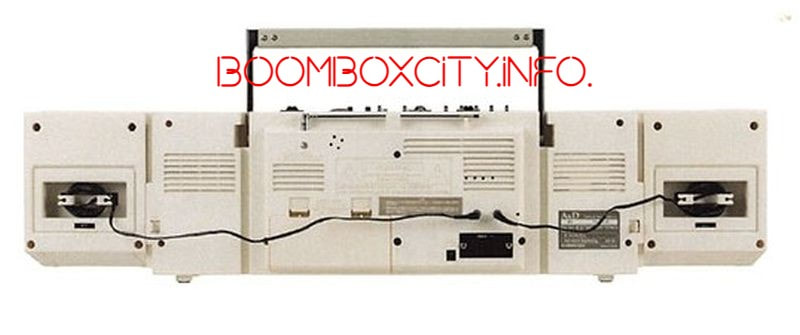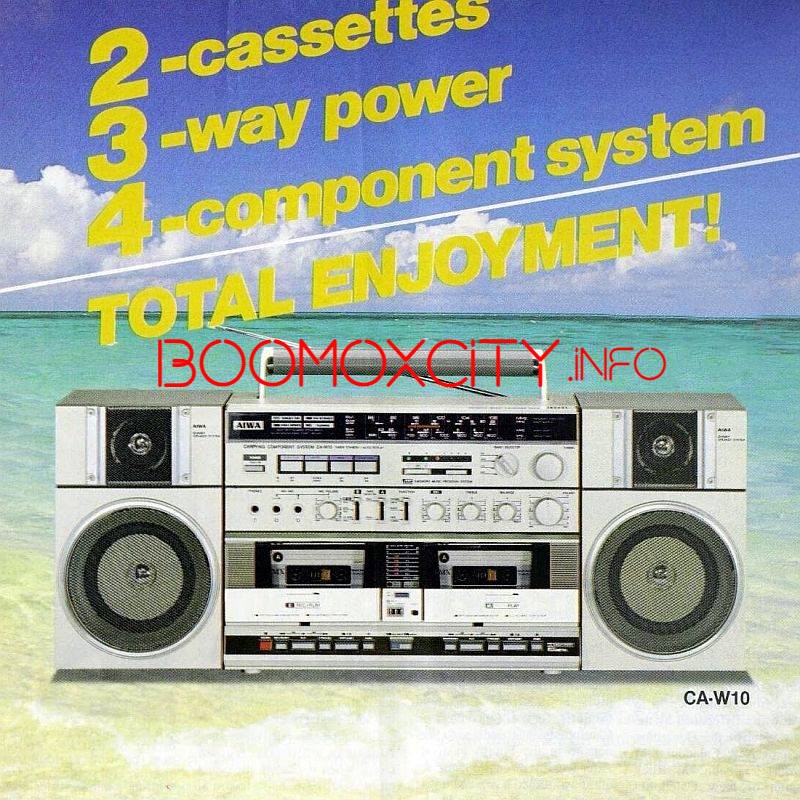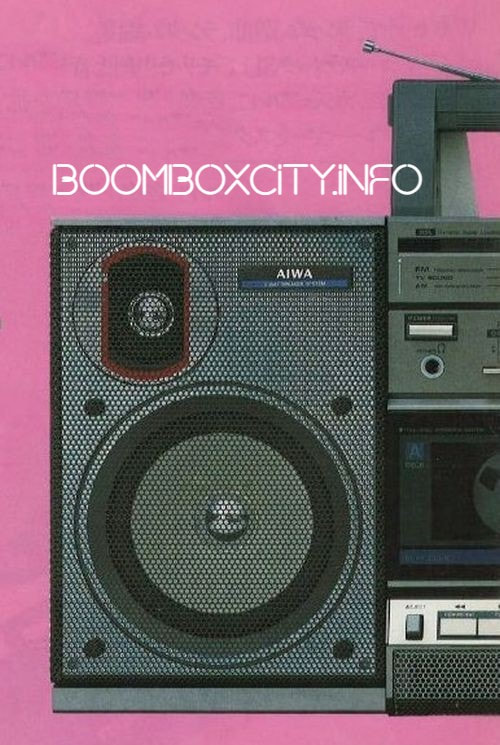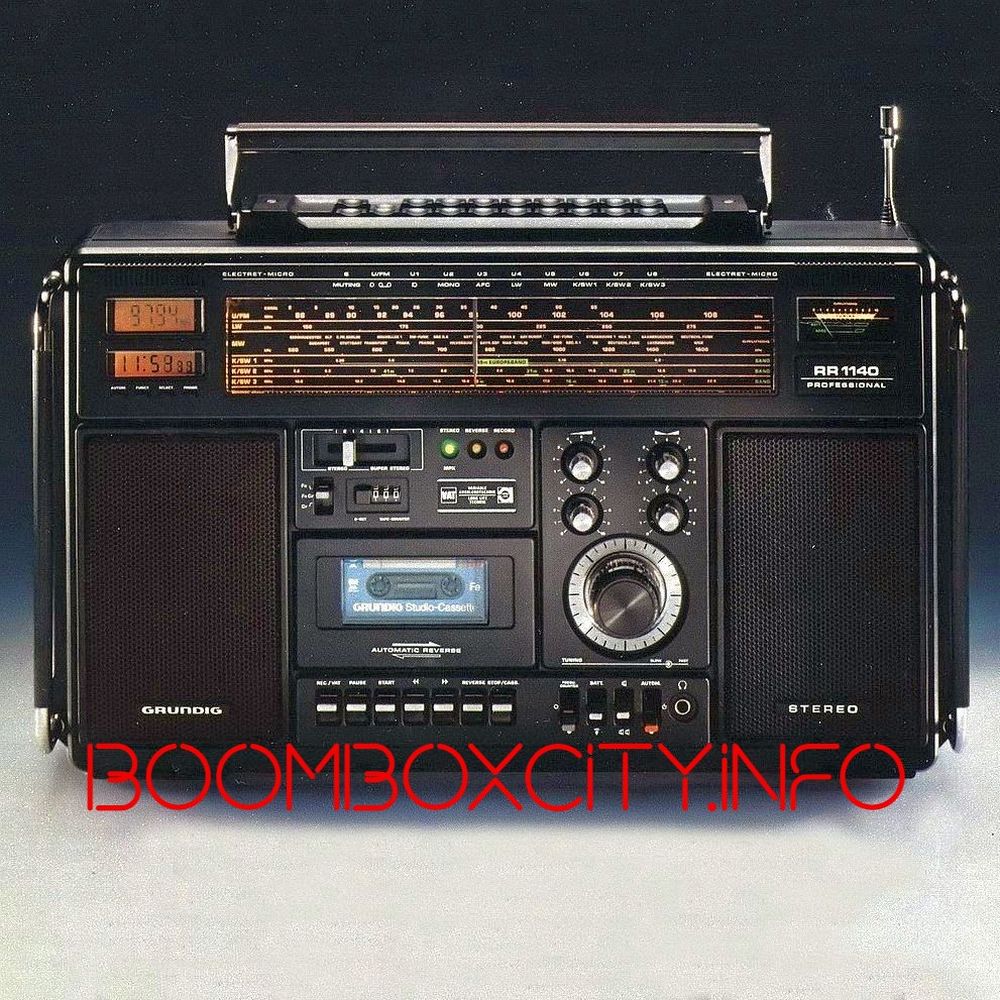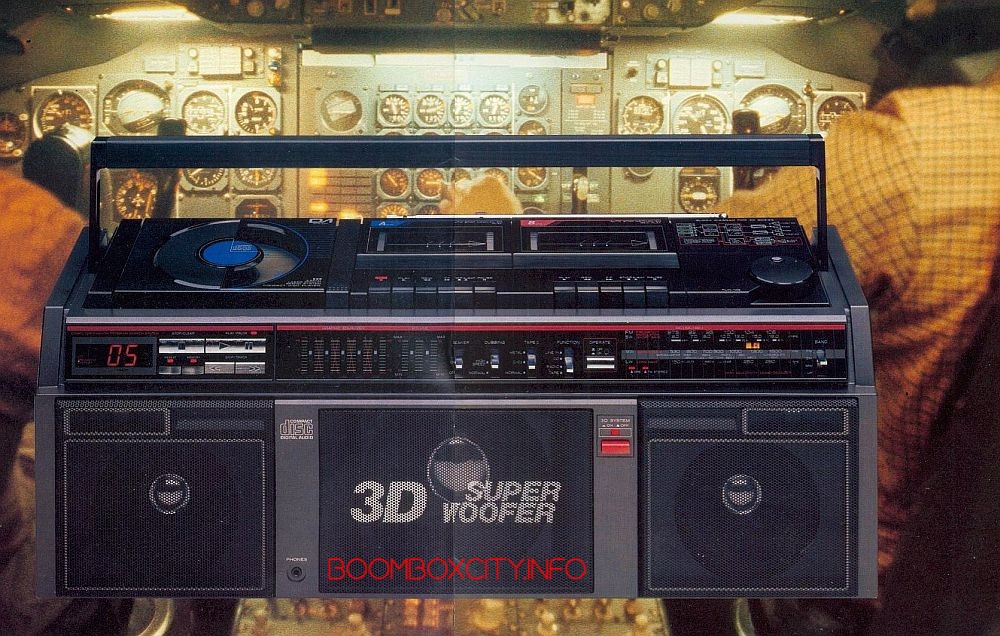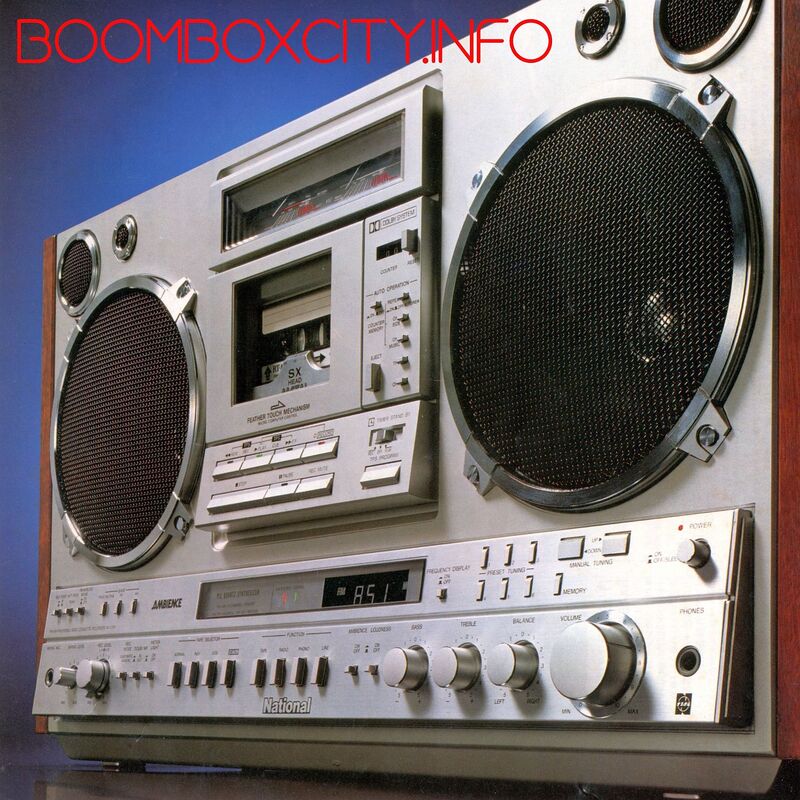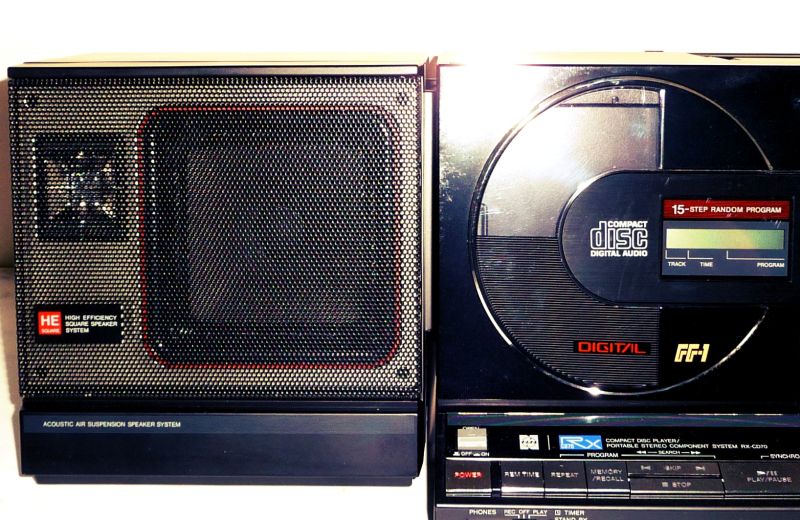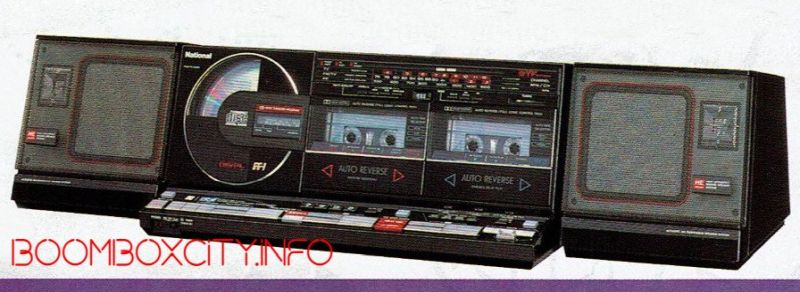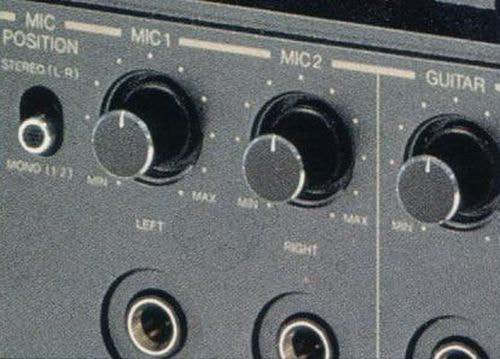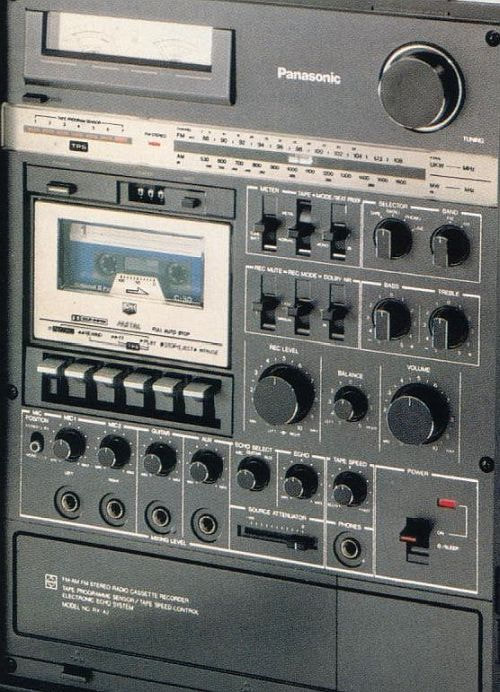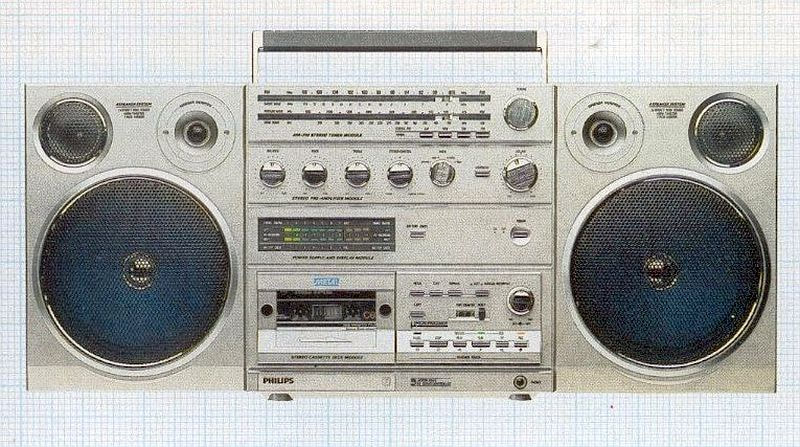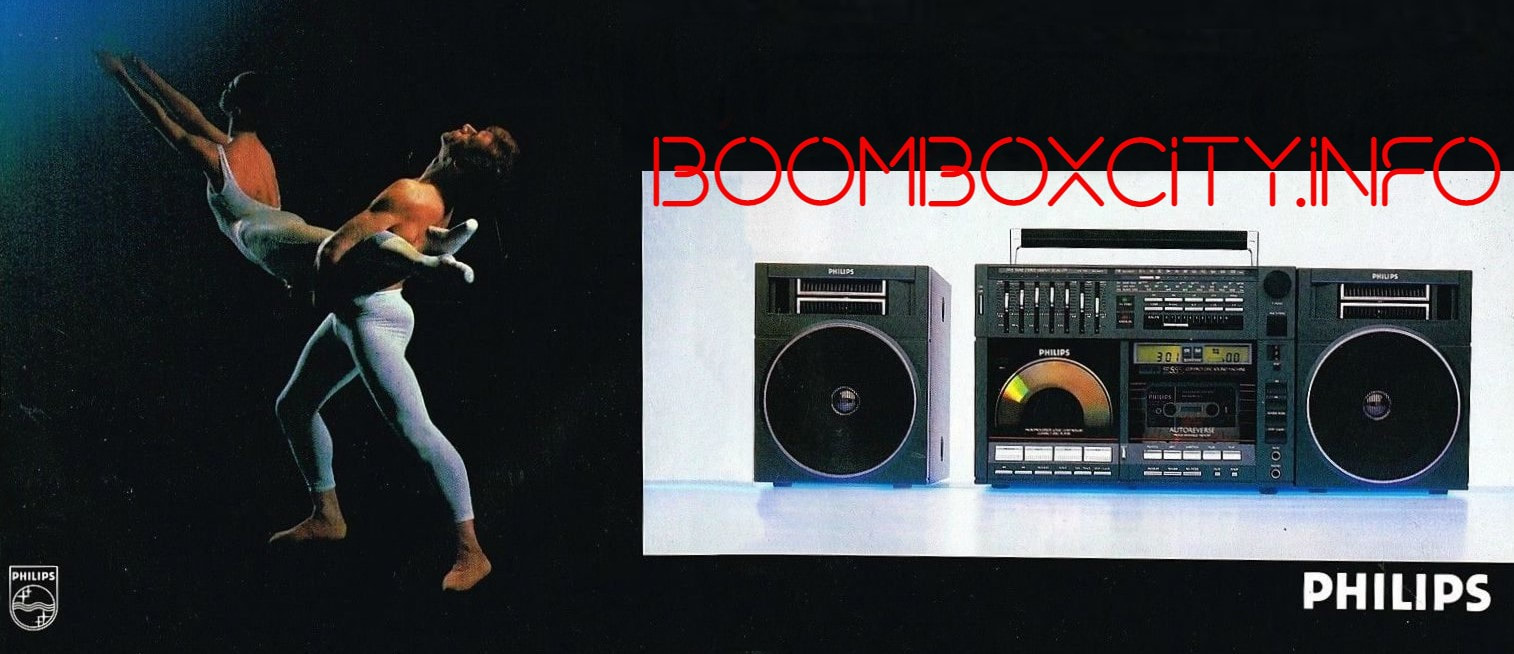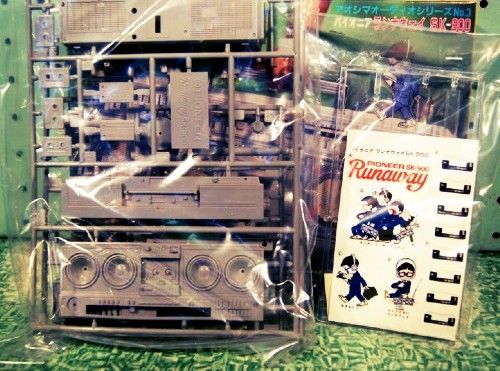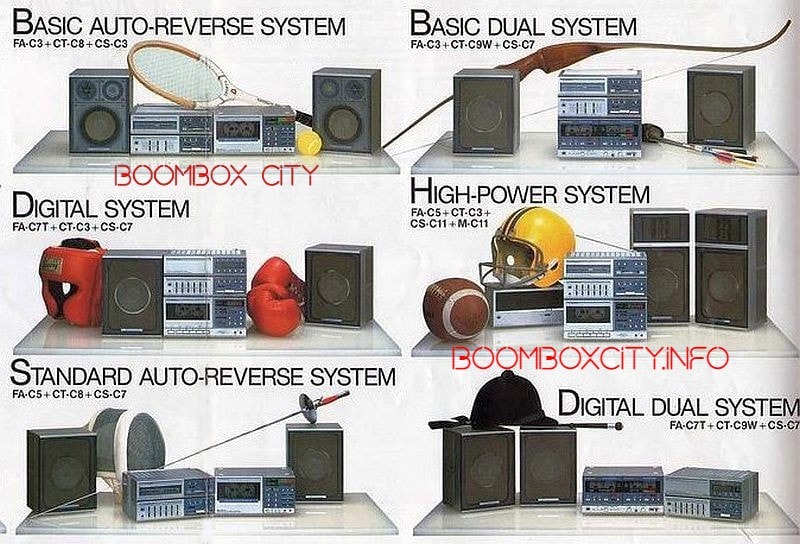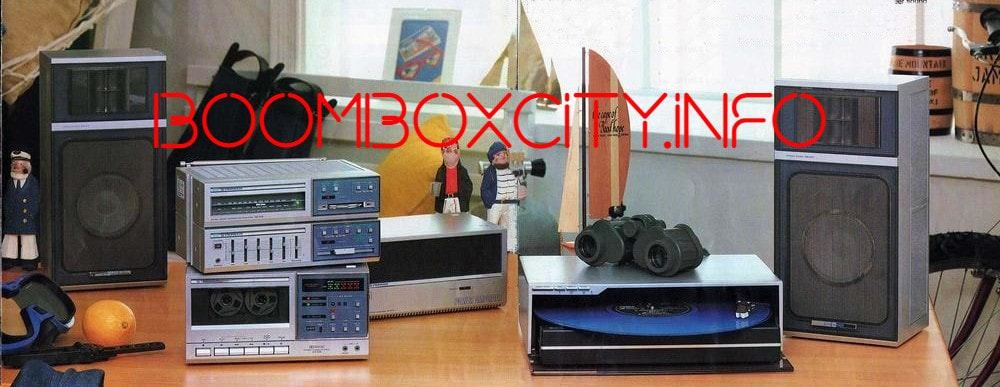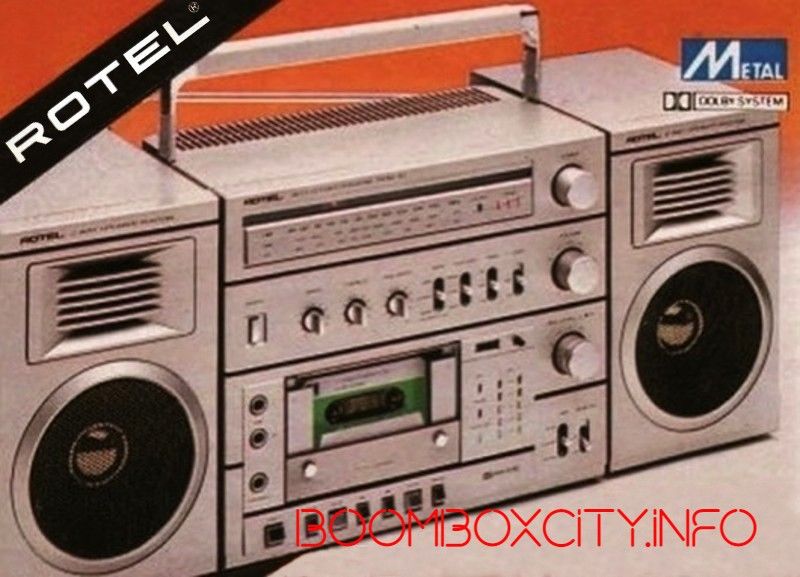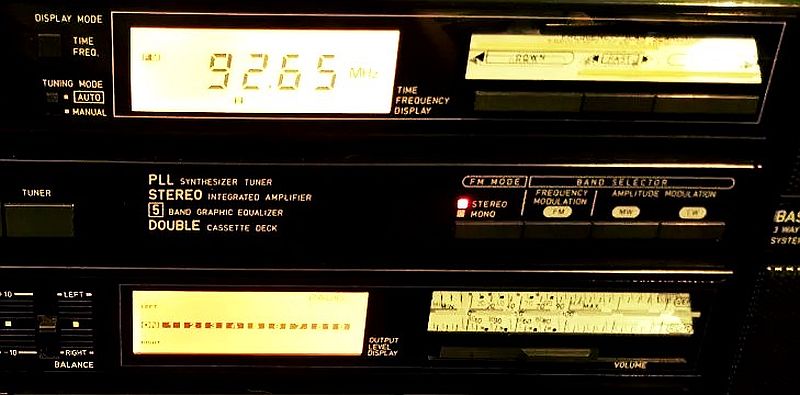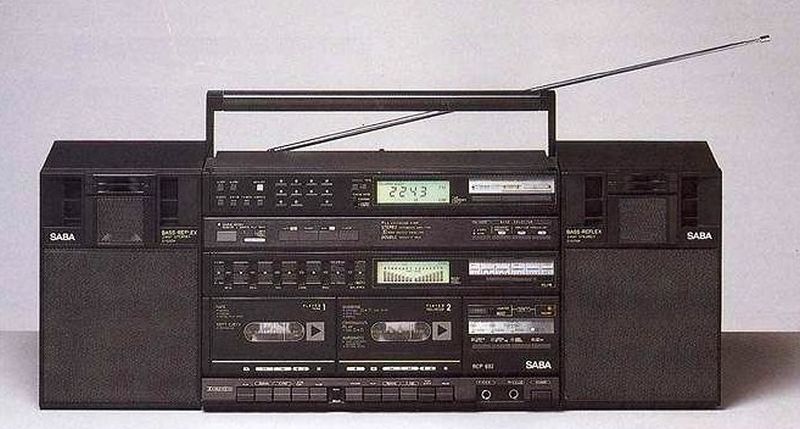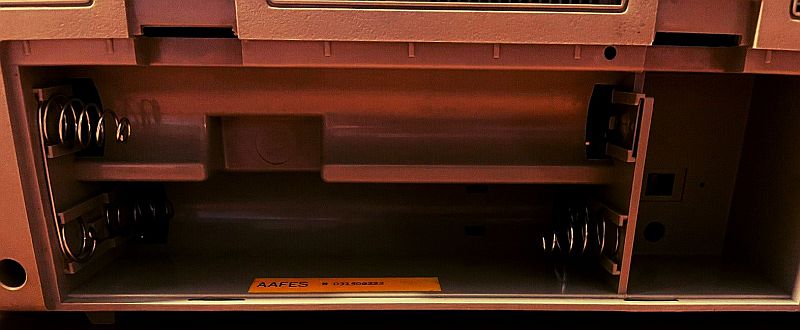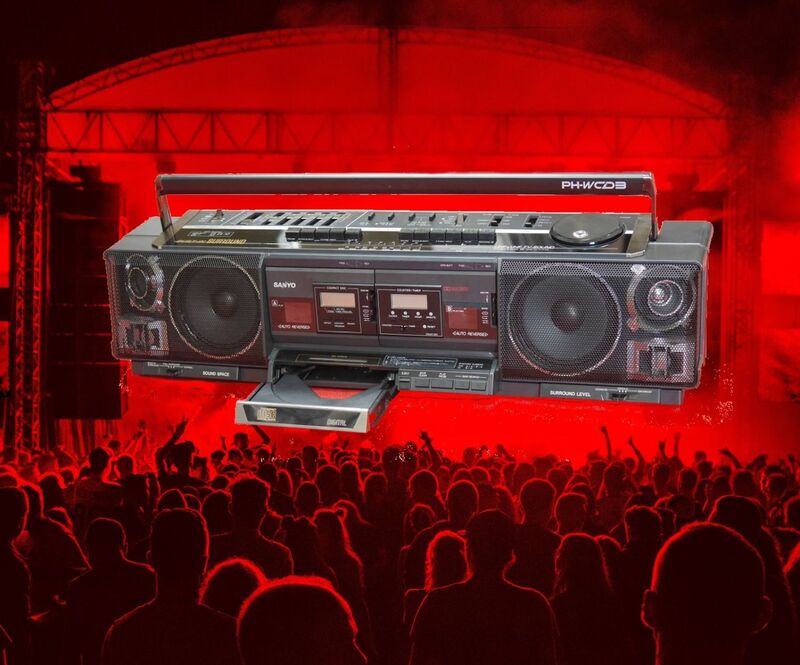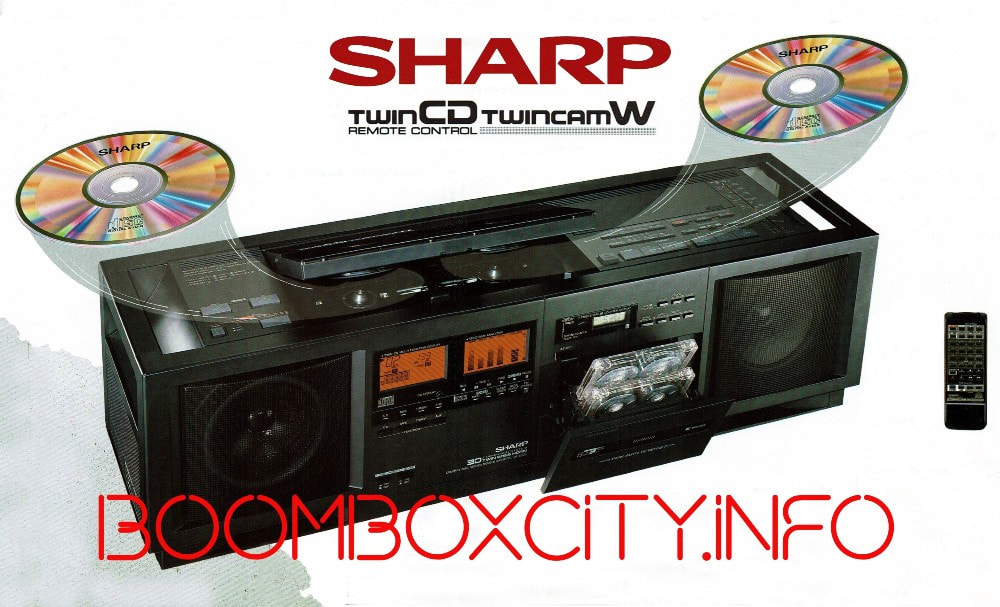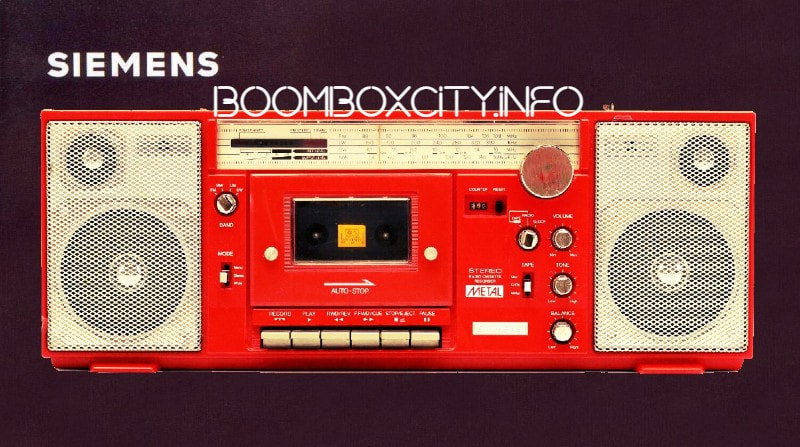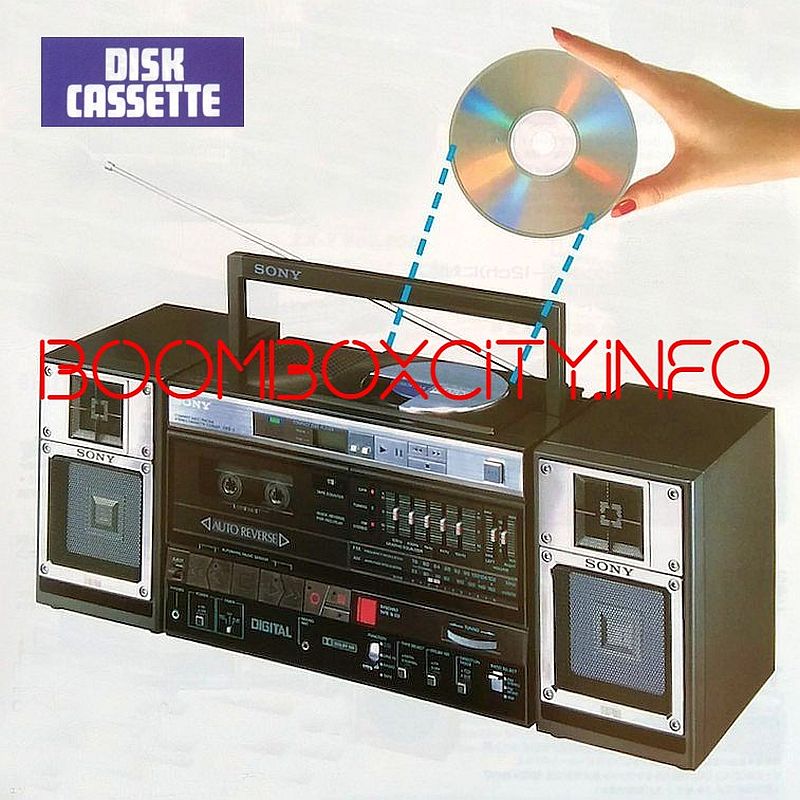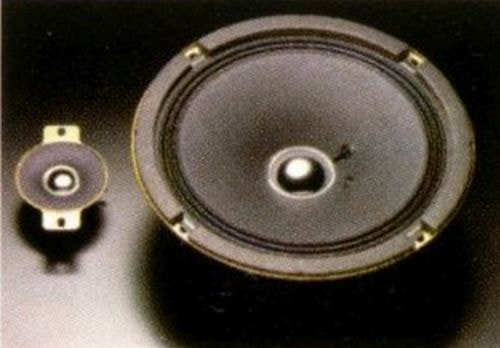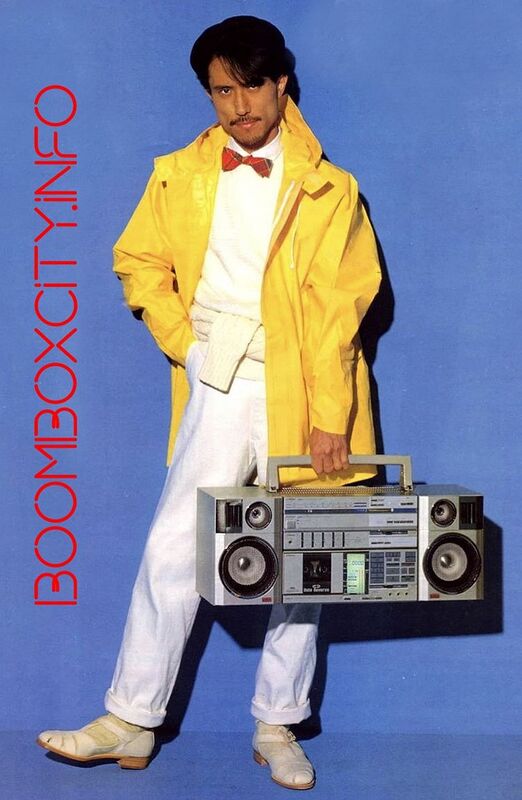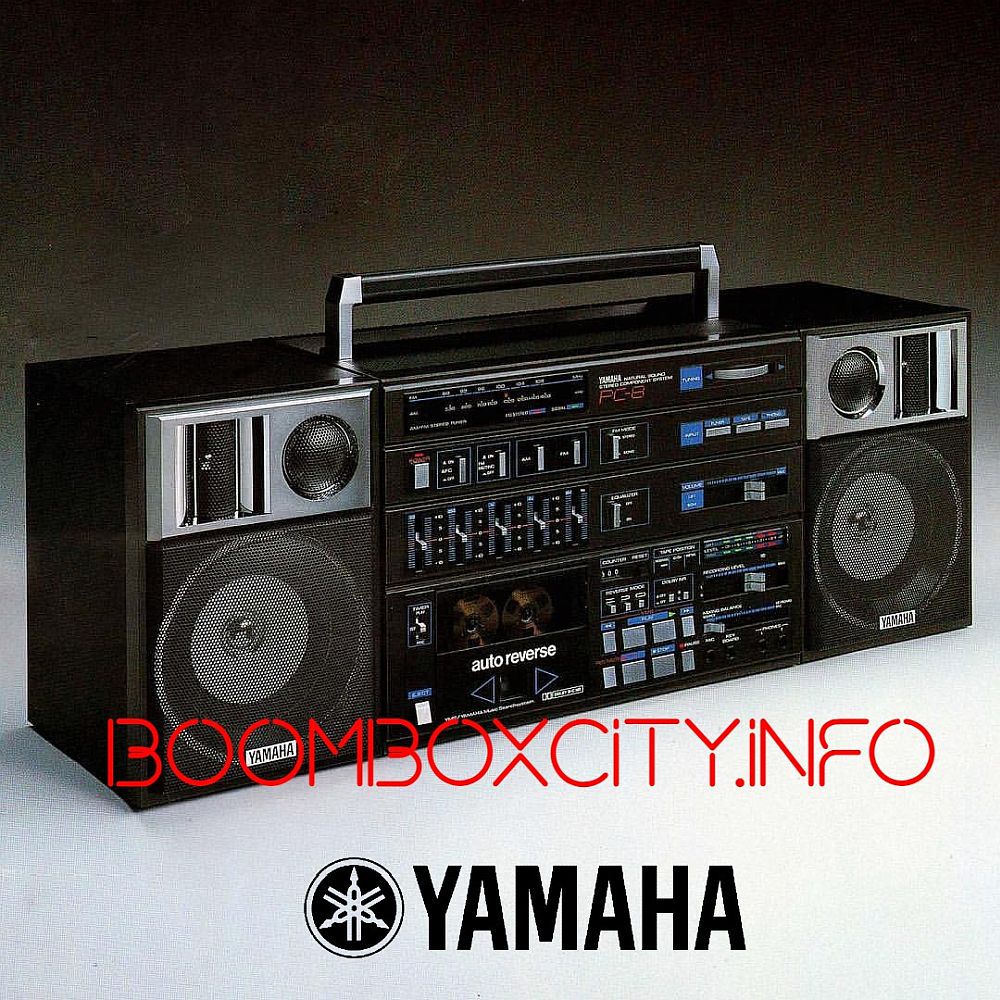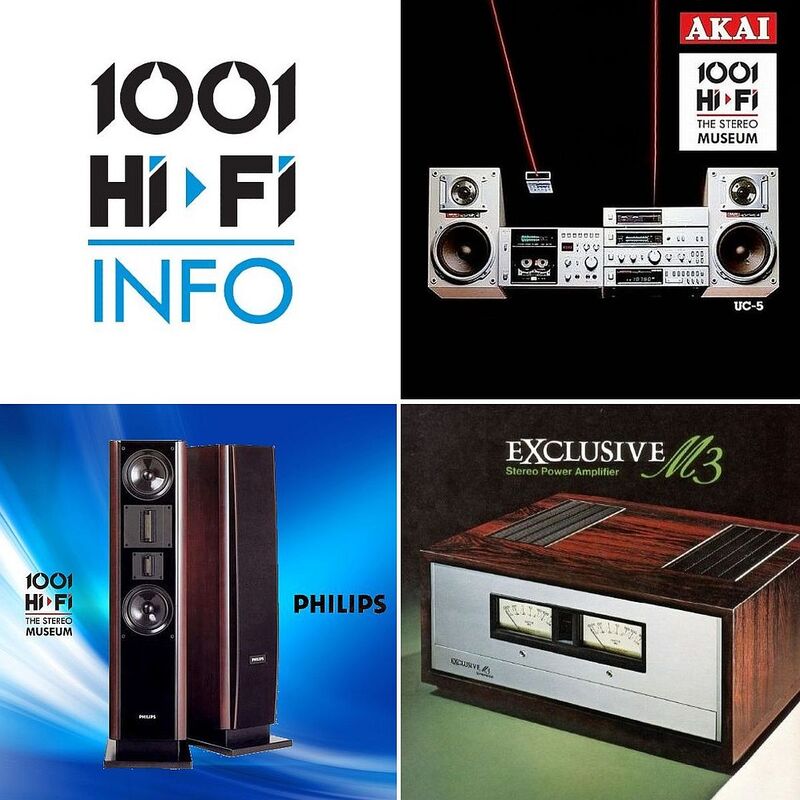A&D TA-57W (1989?)
A full-body experience with 4 detachable speakers and surround sound that transforms your room into a live music venue. This is the TA-W57 from A&D introduced in 1989(?). To enjoy surround sound is really easy. First, remove the 2-way speakers on both sides of the main unit and turn on the surround switch. This will reproduce everything from delicate sounds to intense sounds clearly with the big power of 5W + 5W. If you put the speakers back, you can instantly change to the powerful sound of 2 speakers per channel. (The cord length is approximately 1.2m). Previous radio cassette players were difficult to hear when placed on the floor. Therefore, by tilting the entire body slightly upwards, we are able to hear the clear sound coming from the speakers. A 5-band graphic equalizer allows you to freely choose your favorite sound quality. When you don't have much time, high-speed dubbing of a cassette can be fun. It will work perfectly with any type of tape and will play it back with great clarity. Sometimes it's refreshing to actively listen to TV programs. With the integrated VHF TV tuner you can easily check the TV audio of popular programs. Enjoy FM, AM, and TV listening to your heart's content. With relay playback, you can stay with the person you care about forever. Even when the tape ends, it automatically plays Tape II immediately. This means you can spend twice as long with your boyfriend or girlfriend when listening to music. You can have a happy time and get good sound at the same time. When it comes to singing, the microphone mixing is second to none. The mic mixing function allows you to perform a duet with your favorite musician right away. Master your favorite songs with easy controls. Technical data: Maximum output: 5W+5W (EIAJ THD 10%) | Speakers 10cm cone type x 4, 3cm piezoelectric type x 2 | Frequency characteristics 60-12,000Hz (normal tape) | Power supply: AC100V(50/60Hz), DC12 V (AA batteries x 8, sold separately) | External dimensions: Width 726 x Height 160 x Depth 168mm | Weight:5.4kg (not including batteries)
AIWA CA-W10 (1982)
|
Here's a distinctly "un-portable" sounds, with high output power and - thanks to AIWA's exclusive D.S.L. circuitry - bass realism that has to be heard to be believed! Double-speed cassette dubbing at the touch of a button lets you produce high-quality recordings in half the time. The amplifier section of the CA-W10 from AIWA is Powerful. Low-distortion sounds takes on a completely new quality, thanks to Dynamic Super Loudness. A specially developed circuit which enhances bass reproduction, D.S.L. gives cassettes, radio or externally connected music sources a richness and depth you'd never believe possible from a portable unit. The CA-W10 also features connections for microphone mixing/PA use, LINE IN/OUT terminals and PHONO connections jacks. Truly a versatile machine! The Tuner section: In addition to beautiful FM Stereo, you'll get AM and two shortwave bands. Stable reception with distinctive stereo separation is ensured by use of a PLL IC in the tuner's multiplex stage. Other features include FM stereo and signal strength LED indicators and a wide, easy-to-read dial scale. The cassette deck. Just touch the "Synchro Dubbing" control and the CA-W10 will start to dub your original cassette automatically. In a hurry? Then make copies at double-speed and have 60 minutes of music recorded in just half an hour.
|
You can also load two recorded cassettes and play them in sequence: after the first stops, the second begins, to give you an hour and half of uninterrupted music (with two C-90 cassettes). Metal-compatible units boast a low 0.045% (WRMS) wow & flutter and there's also Dolby noise reduction to silence tape hiss. Metering is by two rows of peak-reading LEDs. The speakers. Capable of wide 50-18,000Hz frequency response for superb music realism, these acoustic suspension speakers can be easily detached from the main unit with the cords provided. And no connection cords are necessary when used or carried while connected to the main unit. Large 12cm woofers and 5cm dome tweeters provide distinctive balance between lows and highs. Size: 645x250x198mm | Weight: 9.8kg
AIWA CA-W2 (1983)
The Carryin' Compo W2 (CA-W2) was introduced by Aiwa in 1983, February to be more precise. The CA-W2 is no ordinary double cassette recorder with features like double-speed dubbing at a single touch, random programmable auto dubbing of up to 10 selections. With automatic tape selector and "Synchro Dubbing" your tape copy starts at the touch of a button, with high speed dubbing while you can listen to the radio or any external component. The tuner section features AM-FM Stereo and TV Sound reception. The amplifier section delivers 30W/ch (when used on AC power) and it features DSL (variable Dynamic Super Loudness system), treble control and microphone input with level control. The loudspeakers are two-way detachable speakers (12cm woofer + 5cm tweeter). The additional Acoustic 3D system is inside the main unit and it's actually a passive radiator that is activated only when the loudspeakers are attached to the main unit. The addition of the RK-W2 rack allows you to easily add and install a turntable to your CA-W2 such as the LX-7 programmable linear tracking model. Size: 630x292x190mm (WxHxD) | Weight: 10,8kg | The CA-W20 model designation is the International market version.
Aurex RT-CDW70X (1987)
The CDW70X was Toshiba's first double cassette CD radio cassette recorder sold in Japan under the Aurex brand name. This model was the world's first to feature CD double-speed dubbing, just press the double-speed dubbing button for double-speed dubbing from CD to tape or tape to tape. If you specify the tape type (time), the microcomputer automatically calculates the distribution of songs to be recorded on tape sides A and B. Just press the one-touch dubbing button to record on both sides of the tape. The RT-CDW70X has a built-in DBSS (Dynamic Bass
Sound System) super woofer system. An 8W amplifier dedicated for the super woofer, a 10cm woofer at the bottom of the unit, and a resonant space provide powerful sound. The cassette section is a feather touch controlled twin reverse cassette mechanism. A full function wireless remote control was standard equipment for the unit. The radio section in addition to FM/AM radio can also receive stereo TV sound such as MTV. With the built-in timer both ON and OFF time can be set. With the optional SS-SR1 speaker system you can create a surround sound space. These speakers come with a remote control and feature a built-in 2,3W+2,3W amplifier. This configuration also makes them suitable for use with a walkman. A newly developed high-performance LSI (TVP47P860F), the "XDR" (Extended Digital Revolution) brings advanced electronics technology for efficient CD and tape editing functions. Accessories: Wireless remote control | timer batteries (AA x 3) | remote control batteries (AAA x 2) | AC power supply | Maximum external dimensions: Width 645 x Height 198 x Depth 204mm | Weight: 7.8kg
Sound System) super woofer system. An 8W amplifier dedicated for the super woofer, a 10cm woofer at the bottom of the unit, and a resonant space provide powerful sound. The cassette section is a feather touch controlled twin reverse cassette mechanism. A full function wireless remote control was standard equipment for the unit. The radio section in addition to FM/AM radio can also receive stereo TV sound such as MTV. With the built-in timer both ON and OFF time can be set. With the optional SS-SR1 speaker system you can create a surround sound space. These speakers come with a remote control and feature a built-in 2,3W+2,3W amplifier. This configuration also makes them suitable for use with a walkman. A newly developed high-performance LSI (TVP47P860F), the "XDR" (Extended Digital Revolution) brings advanced electronics technology for efficient CD and tape editing functions. Accessories: Wireless remote control | timer batteries (AA x 3) | remote control batteries (AAA x 2) | AC power supply | Maximum external dimensions: Width 645 x Height 198 x Depth 204mm | Weight: 7.8kg
DENON DOing H-5 (1982)
Denon has supplied the broadcasting industry with professional equipment for many years and met with highest acclaim. As a result of this experience in 1982 Denon introduced the H series boomboxes. The H-5 is a portable system that consists of 4 separate units. To increase portability by reducing weight, the main body that contains the cassette recorder and radio could be separated from the loudspeakers and the amplifier module that was housing the power transformer for mains operation. The amplifier however could not be used as standalone unit because the source selector was located on the main unit. When fully assembled the amplifier could deliver 20W/ch to the removable 2-way wood speaker system with 10cm woofer and 5cm tweeter. When the main unit is used in "Walking Style" (with the amplifier removed) you will have to use headphones (AH-P5) that also have a dedicated storage place on the top of the unit. The cassette recorder section is Metal tape capable and it features Dolby B noise reduction system as well. For full a musical experience an external turntable can be connected to the system. Dimensions: 613x308x206 mm | Weight: 11.8kg | Operation: Mains, 8 batteries and 12V car power. The Denon H-5 was available in silver and black.
GRUNDIG RR 1140 PROFESSIONAL (1980)
The RR1140 Professional was introduced by Grundig in 1980. It is a fully featured "dream" model in a relatively compact body. The radio section has 6 bands: FM Stereo, AM, LW and 3 SW bands. This is an analog tuner doubled by a Digital frequency display, memory for 8 FM programes and fine station tuning. Below the frequency display there is an LCD clock-timer section with date display. The cassette recorder is an auto reverse model with Long Life head that can handle Normal, FeCr and Chrome tapes and is fitted with Grundig's VAT-system for smooth in and out fading of recordings. The amplifier section delivers 10W Music power per channel driving a 2-way "Superphon" loudspeaker system. This system contains a large oval loudspeaker with a tweeter mounted in the front of-it. This system makes possible to build a compact body while keeping a large cone area for bass reproduction. The unit has connectors for headphone (6.3mm), external loudspeakers (DIN socket), external tape recorder and FM antenna. The unit can be powered from mains, 6 D-cells or a "Grundig Accu 476" rechargeable battery. This model was replaced by the RR1140SL that had a different speaker grill and was available in both black and silver versions. Size: 54x34x15 cm | Weight: 9,6kg. Original sale price 1298 DM in Germany.
HITACHI TRK-CD3 (1986)
With the growing popularity of CD, Hitachi introduced a new model in their famous "3D Super Woofer" series - this time with a CD player - the TRK-CD3. Depending on the market where it was commercialized it can also be found as CX-W800 or CX-CD9. The highlight of the system is of course the 3D Super Woofer speaker system. This system consists of one large 16cm woofer and two 12cm speakers with coaxial tweeter. This acoustic system is powered by a 31-Watt amplifier (8Wx2 + 15W - AC 10% THD). The amplifier section also features a 5-band equalizer, on-off switch for the super woofer and input for external sources. Hitachi recommends the HT-W03CD turntable with built-in phono equalizer. The radio section is a standard analog tuner with manual tuning that can receive FM-Stereo, MW, LW and SW radio broadcasts. The CD player is located on the top left of the unit, thus being a top loader model while the controls are located on the front where only a basic LED display shows the track number. Also on the top, next to the CD player, there is a double cassette system with one cassette recorder and one for playback only. Recordings can be made from various sources such as radio, CD or you can copy a cassette at double speed if you need to. The cassette section can handle Normal, Chrome and Metal tapes with a frequency response of 40-13.000/14.000/15.000 Hz (normal/chrome/metal). Size: 62x23x21,6 cm | Weight: 8,7 kg | Operation: Mains or 12V DC (8 batteries).
ITT Super-Touring 350 (1986)
The ITT Super-Touring 350 was introduced to the European market in 1986. This is a large portable unit measuring 74,6x25x12,5cm consisting of the main unit and detachable two-way loudspeakers. What is unusual is the fact that the main unit consisting of a 4-band radio, cassette recorder and amplifier also incorporates a 5th speaker. This means that if you want to take this unit outdoors you could do this without taking the detachable loudspeakers with you making-it easier to carry around. The radio section features FM-Stereo, MW, LW and SW wavebands. There are also 5 FM presets with tuning knobs located at the back of the unit. The amplifier section is specified at 40W Peak power and it has the slider controls for bass, treble, balance and volume on the front panel while the source selector on top of the unit. The cassette recorder section is soft-touch controlled with track search function and manual tape selector for Normal, Chrome and Metal tapes. (30-14000 Hz Metal). The recorder has also Dolby noise reduction circuit and manual record level control. On the back panel there are RCA inputs for turntable and DIN standard in/out for additional recorder. The loudspeaker connectors are also DIN standard. The unit can be mains operated or battery operated (8xD cell) and it weighs with the detachable loudspeakers 6,5kg. These units were Made in Malaysia for ITT.
JVC RC-M80 (1980)
The RC-M80 was introduced by JVC in 1980 and it was positioned below the top of the range RC-M90 model (see here) and above the highly popular RC-M70 model. Visually all controls are placed on the front panel. In the upper left section, we have the radio section with a unique pure-electronic voltage synthesizer tuning circuit and a 32 LED tuning indicator on the tuning dial. Automatic station scanning in both up and down scanning direction is possible with 12-Station random preset capability (6FM and 6 other stations). The cassette recorder features a two-motor full-logic tape transport with an extremely low wow and flutter of 0.055% (WRMS) and feather-light touch tape control buttons. The recorder is fitted with SA (Sen-Alloy) Record/Playback head and 2-Gap SA (Sen-Alloy) Erase head for Metal tape compatibility and a three-step ALR (Automatic Recording Level) select switch for Normal, CrO2 and Metal tapes. Direct mode change, quick cue and review function and SMS (Single Music Scanner) in either direction is also included. The amplifier section has an output power of 6 watts per channel (EIAJ/DC) delivered to a set of two-way loudspeakers featuring 16-cm woofers and 5-cm tweeters. External antenna and speakers can be used and there are also a Line In/Out terminals provided. Full remote control of tape operation is possible via the optional wired remote control unit R-15E. Size of the unit: 521x301x137 mm | Weight: 8 kg | Operation: mains, 10 D-cell, car battery.
JVC PC-5 (1981)
The JVC PC-5 from 1981 is more than a simple boombox. It was advertised as The Quintet because the system is actually built from 5 independent components. For home use the amplifier, tuner, cassette deck and the two loudspeakers can be placed in any configuration you want. If you wanted a portable unit, all these components could be assembled into one piece and with the added handle it could be easily transported. The amplifier section is a 20W/ch max. power unit (10W/ch DIN 45500) with independent left and right channel IC modules. The amplifier contains the mains transformer which means that the amplifier could be used independently but it will also power the other components of the system. The sensitive tuner brings four radio bands, including FM stereo, AM and two short-wave bands. Clean, low-distortion FM stereo reception is delivered by a PLL circuit. The cassette recorder section is an advanced 2 Motor Full Logic controlled unit featuring JVC's own SA-heads and ANRS (Dolby compatible) and Super ANRS noise reduction systems. Recordings can be made on all tape types, Normal, Chrome and Metal while the recording level can be set manually and visualized on a very basic LED VU meter. It is the cassette deck that contains the battery compartiment which means that the whole portable system will be battery powered by the cassette deck which in turn can be used independently as a field recorder if necessary. The loudspeaker looks like a two-way speaker but it actually contains one 10cm full range driver while the "tweeter grill" only hides the bass-reflex opening. There is however an additional bigger loudspeaker set (RB-95) sold as an accessory for home use that is a genuine two-way loudspeaker. Among other accessories we could mention the L-E5 Linear Tracking turntable and the R-15E wired remote. Fully assembled Dimensions: 538x294x243 mm | Weight: 12.9kg | Operation: Mains, 12V ext., 8xR20 batteries.
LASONIC TRC-931 (1985)
The LASONIC TRC-931 is a true Cultural Icon. It was introduced in 1985 and it was manufactured in Taiwan by Yung Fu Electronic Appliances. The LASONIC brand name is composed of LA "Los Angeles" and SONiC, as in ... "supersonic". Main features of the TRC-931 are: 5 band graphic equalizer, dual cassette (slot-in autoreverse and front-loading recorder), 20cm Bass-Reflex Woofer, 5cm high-frequency cone tweeters, 15W/ch 4ohm, soft touch tape mechanism, built-in condenser microphone, microphone mix volume, line-in/line-out and phono input. Dimensions: 635x360x156 mm | Weight: 8.6 kg | Operation: AC, 10 "D" cell batteries, Car battery. The same boombox was also sold rebadged as CROWN SZ-5000L or UNISEF SZ-500SL.
National RX-7200 (1980)
The RX-7200 was a high-quality portable unit introduced by National (Panasonic) in 1980 to the Japanese market. With its luxurious wood side panels, it is more like a home hi-fi (with a matching stand sold as accessory) with a handle and battery operation. The cassette recorder section is full logic controlled with a wow & flutter figure of 0.05% and Metal tape compatibility (SX head and 30-18000Hz Metal tape). It has manual record level adjustment, VU meters and Dolby noise reduction. The radio section is a highly accurate Quartz PLL synthesizer tuner with Digital display and 12 station memory. The amplifier section delivers 25W (EIAJ/DC) total power to a loudspeakers system with a 16cm woofer and 5cm tweeter. It also features an Ambience circuit for wider stereo separation. At the back there is input for a turntable, an auxiliary unit but also output sockets. At the front there is provision for microphone input with mixing possibility. The RX-7200 can be remote controlled with the RD-9840 wired remote control. Size: 612x345x178 mm | Weight 10.8kg | Operation: Mains, Car (with RP-9550 adapter), 8 D-cells.
National Panasonic RX-CD70 (1986)
Imagine a place where there is no noise. Absolute silence, broken only by the purest, cleanest music you've ever heard. That place is inside your head. And you can hear that incredibly pure music on any of the portable Compact Disc players by National Panasonic. The RX-CD70 was introduced in 1986 and it was branded as National for the Japanese market and Panasonic the worldwide version. They are basically identical models with the Japanese market National model featuring a TV tuner section too, for stereo TV broadcasts. The CD section of the RX-CD70 features a vertical loading player with FF-1 Fine Focus Single Beam laser and 15 track programs. The cassette section features twin auto-reverse logic-controlled units where one is playback only and the other is recorder with reverse recording capability. They both can handle normal/chrome/metal tapes with a frequency response of 40-15000/16000/17000 Hz (normal/chrome/metal) and there is also a Dolby noise reduction included. While the acoustic air suspension 2-way speaker system proudly shows a "High Efficiency Square Speaker System" badge the manual list these speakers as a 10cm woofer and 2 cm tweeter. The loudspeakers are removeable too. The power output of the amplifier is specified at 30 W. At the back of the unit, we can find AUX-IN and LINE OUT RCA connectors. Size of the unit: 764x173x237 mm | Weight: 7 kg | Mains and 10 D-cell battery operation.
Panasonic RX-A2 (1980)
This is not your usual "boombox" here. This is more like a portable disco set-up. It was sold with both Panasonic or National badges as RX-A2 or RX-6400. Both hands are needed to carry this 4-piece "party box" as it came with an additional cover for the main unit that will accommodate your cassettes and microphone while the two speakers will be "clipped" front-to-front for a total of 22.2kg. The amplifier section delivers a powerful 25W/ch. (15W/ch. RMS at DC) sound to the 2-way speaker system equipped with a large 20cm bass and 6.5cm tweeter mounted on a wood front panel. The cassette section while is only mechanically controlled it offers manual record level control with two needle type VU-meters, compatibility with normal, chrome and metal tapes, Dolby noise reduction and a music search system called TPS. The radio section is a basic AM-FM Stereo analog tuner. At the bottom section of the front panel are located a series of inputs with volume control for microphone, guitar, aux with echo function and this is where the tape speed control is also located. The battery compartment is also located on the front and it requires 10 D-cells. At the back there is provision for external source with line in-out and phono input for a (DJ?...) turntable. Size: 957x443x290 mm with components linked and opened | Total weight 22.2kg | Operation: mains, battery (10 D-cell) and car battery.
PHILIPS D8814 (1981)
The PHILIPS D8814 was introduced in 1982 and it's an upgraded version of the D8714, with added Digital clock and Digital display for the radio section. Due to it's "space age" styling it is affectionately called "The Elephant" by enthusiasts. Technically it belongs to the top-class portable recorders (boombox) featuring all the bells and whistles borrowed from full size High-Fidelity components. Even though the cassette recorder section features a basic mechanically controlled unit this is capable of handling Normal, Chrome and Metal tapes and it also features Automatic but also manual recording level setting with LED recording level meters and Dolby noise reduction. On top of this the cassette recorder section has a Digital counter (a not too common feature even on separate Hi-Fi components of this age), ACS - Automatic Computer Search for up to 19 tracks on a cassette and Memory Stop. As usual with Philips, this model also features the well-known Philips Long-Life head. The radio section of the D8814 features a Digital LCD frequency display and fine-tuning knob for AM and SW radio stations. It has to be mentioned that all the "Digital - LCD" panels are sourced from Sharp-Japan. (More about Philips-Sharp in the TV to GO section). The amplifier section is specified at 10W/ch that drives a - 7" Woofer 2" Tweeter 4Cone speaker system. Even the front grill suggests that there is a separate tweeter inside but in reality, there is only a large woofer with a whizzer acting as high frequency extension. The truth is that this type of speaker works brilliantly in such a portable system. So, you think this is all? No, this top quality boombox also features a Quartz Clock with Digital display, Timer function for radio and cassette and a 0-99 minutes sleep timer function. Wait, there is a Phono-Line input as well for external sources and line-out connectors as well ... and connectors for external loudspeakers. Size: 480x28x140 mm | Weight: 6.6 kg (batteries included) | Operation: 12V car, 8xD cells.
PHILIPS D8614 (1982)
Think of the Philips Sound Machine as a sound factory. The D8614 was the first model in a new and modern boombox series introduced by Philips in 1982. The amplifier section is specified at 3.5 W/ch in battery operation mode and 5W/ch if the unit is operated from the mains. Most brochures specified 10W/ch Music Power. The speakers consist of a 17 cm woofer and one tweeter per channel. There are separate tone controls for bass, treble and Loudness. The amplifier also has continuously variable Mono-Stereo-Stereo Spatial setting, Phono input and Line In-Out connectors at the back. The radio section has FM-Stereo, MW, LW and SW wave bands. The cassette recorder section uses a feather touch Micro Processor controlled 3 Motor Drive unit equipped with Longlife heads. There is manual tape selector for Normal (50-12000Hz), Chrome (50-14000Hz) and Metal tape (50-15000Hz) while the record level setting has Automatic or manual level setting used with a two colour LED VU meter. Dimensions: 610x250x130 mm | Weight: 6.5 kg | Operation: Mains, 12V external, 8xR20P batteries. A black version was sold under the Radiola name, a Philips sub-brand.
PHILIPS D8254 (1985)
Part of a design-oriented range, this is the D8254 from Philips. It was introduced in 1985 as part of the "Cubic Compo" range. It's a 3-piece boombox with red body and black front. The main unit features long, medium, short and stereo FM wavebands. The amplifier delivers 2x5W while the bass, treble, volume and Stereo Spatial sliders are situated on the front of the unit. Even though this is a basic portable unit the cassette recorder features soft-touch tape transport with Longlife head and Normal/Chrome tape compatibility. Inside the clip-on "cubic" loudspeakers we can find 10 cm full-range drivers. Dimensions: 575x155x160 mm | Weight: 3.8 kg | Operation: Mains, 6xR14S batteries.
PHILIPS CD555 (1985)
World First CD Boombox
Philips, creators of Compact Disc technology, have created the pure, perfect and powerful sound of the CD 555 - The World First CD Boombox. New-generation integrated circuits and a new ultra-compact laser assembly. That's how Philips have made Compact Disc transportable. A player with just the same specifications, just the same fingertip facility as a Philips home player (you can even connect it directly to your HiFi system as the CD source). Next to the CD player is a HiFi cassette deck. Among the host of high-spec features in the cassette deck you will find a SER solenoid electronic soft-touch tape transport, exclusive Philips Azimuth tape guidance, Long-Life head, Dolby B noise reduction, automatic tape selection and a LCD display to show the exact state of operations. With the APLD, Automatic Program Loading Device, you can select up to 20 tracks to play in any sequence (from a single side of the cassette). The Record Sync facility automatically starts the recording at the same time as disc playback - at any chosen track. Auto Record Pause automatically inserts 4-second intervals between recorded tracks, to make sure of error-free track search and programming. You can, of course, record from the tuner too, or from external sources including record player, cassette deck, TV set or microphone. The tuner section has four wavebands: FM/LW/MW/SW with fine tuning and PLL FM stereo decoder. The amplifier section has a Music power: 2x4 W (12V dc supply) and 2x25 W (220V ac supply), 5-band graphic equalizer and volume control with automatic loudness. For true HiFi sound the Philips Sound Machine CD555 is equipped with a fully-sealed particle board enclosure that can be clipped on or detached from the player unit. These are two-way loudspeakers with a 40mm cone tweeter and a 130 mm woofer. Size: 600(320)x220x200 mm | Weight: 10 kg |Operation: Mains, EM 5555 rechargeable battery optional.
PIONEER SK-909 Runaway (1982)
The SK-909 Runaway was introduced by Pioneer in 1982. According to the literature of the time this model is: "Everything you've ever wanted in a portable. And less. If you've always had a taste for portable stereo with loads of stereo features, but were afraid of gaining weight, try something new. Our new series of Slim-line Personal Stereos. Available with home audio features like stereo AM/FM and cassette, Dolby, Metal tape capabilities, a 6-band graphic equalizer, Music Search (forward and backward), auto replay and direct one-button feature switching. All with about 1/3 less bulk than regular portables. So, finally, you can gorge yourself on incredible sound. And still be able to move." The 40-Watt max. Music power of the amplifier is delivered to a loudspeaker system consisting of a main speaker with whizzer and an additional passive membrane in an acoustically separate enclosure. The cassette recorder allows manual record level setting with two level sliders hidden on top of the unit behind a cover aided by two front placed VU-meters. During these times electronic components were so popular that they even made scale models of these units. A 1/6 scale model was made by Aoshima of Japan. The SK-909 scale model was the "Audio Series No.3" model.
PIONEER CarryCom system (1983)
Pioneer's CarryCom System was a new concept in compact stereo components. It packs like a portable, but unpacks into individual components - speaker systems, versatile stereo FM/AM tuner/amp combo and fully-equipped stereo cassette deck. Together they add up to integrated component system, just like home hi-fis. When sold as complete system the following combinations were available: CK-3, CK-W3, CK-5, CK-7T and CK-R11. Your options however are not limited to these "readymade" combinations as the CarryCom System is a modular system and the components are designed so you can choose exactly the right combination of units that best matches your needs - and your budget. These are the components that you could choose from:
TUNER-AMP: FA-C3 tuner-amp with analog AM/FM Stereo | FA-C5 tuner-amp with analog AM/FM Stereo, 5-band Graphic Equalizer | FA-C7T tuner-amp with Quartz-PLL Synthesizer preset SW/MW/FM Stereo tuner, 5-band Graphic Equalizer. All models feature the same power output: continuous average power 12.5 W/ch, min. at 6 ohm from 60-20.000Hz with no more than 5% total harmonic distortion and the same size, 225x110x150 mm. There was an additional Power Amplifier as well with continuous power output of 30 watts per channel, min. at 6 ohms from 40 to 20.000Hz with no more than 5% total harmonic distortion. Size: 225x110x192 mm, weight: 5kg.
CASSETTE DECK: CT-C3 stereo cassette deck with Dolby noise reduction and Automatic Level Control | CT-C8 stereo auto-reverse cassette deck with full-logic control, auto tape selector (Metal/Chrome/Normal), music search, Dolby noise reduction | CT-C9W stereo double cassette deck with 2+2 motor transport, double speed tape copy, relay play, full-logic control. The CT-C3 and CT-C8 have the same size 225x110x150 mm, and can be powered by any of the tuner-amplifiers or with 10 D-type batteries. The CT-C9W dimensions are 225x110x200 mm and can be operated from the mains or external DC: 12-15V.
SPEAKER SYSTEMS: CS-C3 2-way bass reflex with 12cm cone woofer and 2.5cm Ceramic Tweeter, 6ohm, 50-20.000Hz, 45W, 168x226x150 mm | CS-C7 2-way rear open type with acoustic dampers, 15x21cm Pioneer exclusive Flat Woofer and 9cm cone tweeter, 6ohm, 40-20.000Hz, 100W, 168x226x150mm | CS-C11 3-way rear open type with acoustic dampers, 15x21cm Pioneer exclusive Flat Woofer, 9cm cone tweeter and Ribbon Super tweeter, 6ohm, 30-50.000Hz, 100W, 168x336x150 mm.
Additional components are the PL-C7 belt-drive turntable, AC-C7 accessory case, AD-C23 carrying handle and mounting set.
The Pioneer exclusive FLAT WOOFER covers the front panel of the speaker enclosure edge to edge. You get much more bass in far less space. All the center is a cone tweeter to handle the mid and high frequencies with maximum clarity. A port on the rear, and special acoustic dampers on one side of each enclosure add dimension and authority to the sound. In the 3-way CS-C11 systems, super highs are handled by the Ribbon Super tweeter.
TUNER-AMP: FA-C3 tuner-amp with analog AM/FM Stereo | FA-C5 tuner-amp with analog AM/FM Stereo, 5-band Graphic Equalizer | FA-C7T tuner-amp with Quartz-PLL Synthesizer preset SW/MW/FM Stereo tuner, 5-band Graphic Equalizer. All models feature the same power output: continuous average power 12.5 W/ch, min. at 6 ohm from 60-20.000Hz with no more than 5% total harmonic distortion and the same size, 225x110x150 mm. There was an additional Power Amplifier as well with continuous power output of 30 watts per channel, min. at 6 ohms from 40 to 20.000Hz with no more than 5% total harmonic distortion. Size: 225x110x192 mm, weight: 5kg.
CASSETTE DECK: CT-C3 stereo cassette deck with Dolby noise reduction and Automatic Level Control | CT-C8 stereo auto-reverse cassette deck with full-logic control, auto tape selector (Metal/Chrome/Normal), music search, Dolby noise reduction | CT-C9W stereo double cassette deck with 2+2 motor transport, double speed tape copy, relay play, full-logic control. The CT-C3 and CT-C8 have the same size 225x110x150 mm, and can be powered by any of the tuner-amplifiers or with 10 D-type batteries. The CT-C9W dimensions are 225x110x200 mm and can be operated from the mains or external DC: 12-15V.
SPEAKER SYSTEMS: CS-C3 2-way bass reflex with 12cm cone woofer and 2.5cm Ceramic Tweeter, 6ohm, 50-20.000Hz, 45W, 168x226x150 mm | CS-C7 2-way rear open type with acoustic dampers, 15x21cm Pioneer exclusive Flat Woofer and 9cm cone tweeter, 6ohm, 40-20.000Hz, 100W, 168x226x150mm | CS-C11 3-way rear open type with acoustic dampers, 15x21cm Pioneer exclusive Flat Woofer, 9cm cone tweeter and Ribbon Super tweeter, 6ohm, 30-50.000Hz, 100W, 168x336x150 mm.
Additional components are the PL-C7 belt-drive turntable, AC-C7 accessory case, AD-C23 carrying handle and mounting set.
The Pioneer exclusive FLAT WOOFER covers the front panel of the speaker enclosure edge to edge. You get much more bass in far less space. All the center is a cone tweeter to handle the mid and high frequencies with maximum clarity. A port on the rear, and special acoustic dampers on one side of each enclosure add dimension and authority to the sound. In the 3-way CS-C11 systems, super highs are handled by the Ribbon Super tweeter.
ROTEL RPM-10 (1982)
The RPM-10 was introduced by Rotel with the model year 1982. It is one of the best specified and performing 3-piece portable units. The amplifier delivers 25 watts per channel (music power) and 15 watts per channel RMS (DIN) when powered from AC. The system uses detachable 2-way speaker system equipped with 10cm woofer and 5cm tweeter. The cassette recorder section uses a 1-motor mechanism with High B permalloy laminated head capable of handling normal/chrome/metal tapes (30-14,000/15,000/16,000 Hz). It has manual record level adjustment and LED level meters and Dolby noise reduction circuit. This model was also rebadged as NIKKO NPS-50. Dimensions: 140x234x211 mm | Weight: 2.3kg | Operation: mains, 8 D-size battery.
SABA RCP-692 (1988)
The RCP-692 boombox was introduced by Saba...and Nordmende...and Telefunken in 1988. The reason for this "rebadging scheme" was the fact that by this time all these German brands belonged to the French Thomson group. Actually, this was a promising start for a series of good quality Korean made products that unfortunately didn't last too long. The RCP-692 is a 3-piece portable radio cassette recorder with some very nice features. First there is a Quartz Synthesizer Digital tuner with 10 presets "powered" by a 40W/ch (Peak power) amplifier. Both of these sections feature large back-lit LCD displays. The cassette recorder section is a dual well construction with one recording and one playback unit compatible with normal/chrome/metal tapes and featuring Dolby noise reduction unit. The loudspeakers of this unit are 3-way bass reflex construction. Size: 675x235x165mm | Weight 7,5kg. Original sale price 499 DM.
SAMSUNG ST-575/ST-775 (1982)
The model shown here was introduced by Samsung in 1982. The two variations, ST-575 and ST-775, are basically the same machine with minor differences depending on the market where they were sold. If that's not enough there was also rebadged version sold around the world such as the Candle JTR-1287 (for Canada) and Helix HX-4630. These "Jumbos", as they were marketed in Germany, are very well-made units with good performance. All the controls are situated on the front of the unit. The tuning scale for the AM, FM, SW radio is situated at the upper part. Under this there are a series of knobs and switches for manual cassette record level, tone controls, volume and function selectors. In the middle section we have a one motor solenoid operated cassette recorder with music search function, Metal tape capability while the two large VU-meters are situated above the cassette compartment. Power output is rated at 6W/ch at 10% THD driving a two-way speaker system. Finally, one more detail. If we take a closer look we will see a strong resemblance with the Panasonic RX-5600 model. It looks like if the Panasonic was the basis for this slightly modified Samsung.
Sansui CP-7 (1982)
Imagine the dynamic sound of a quality stereo system. And imagine how nice it would be if you could take this sound along with you wherever you go. Now you can experience the beautiful sound of Sansui in a package so compact you can carry it anywhere. It's the Sansui CP-7 P-Compo System from 1982. Tune to your favorite program (choose from 20 presets, 5 FM, 5 AM, or 10 shortwave bands) or play your favorite tape. The amplifier will always deliver the clearest reproduction of your music source (15 W/ch 4 ohm). And you can program up to three selections in advance on the metal compatible cassette deck using the Automatic Music Program Selector (AMPS), a special Sansui feature. With the convenience of a built-in digital clock, timer and sleep timer, you'll want to take the Sansui CP-7 wherever you go, and it even has inputs for a turntable. Simply lock the speakers and the handle to the main unit using a coin and you will have beautiful music in motion. Size: 530x210x193 mm | Weight: 9.3 kg | Operation: Mains, car battery, 8 D cells. (Also available in black)
Sansui CP-99W (1984)
The CP-99W was introduced as new model by Sansui in 1984. It is a 3-piece portable unit with detachable loudspeakers. The main unit consists of a Digital synthesizer FM/MW/SW1/SW2 tuner with 20 preset stations (5 for each band) and LCD display. The amplifier section features a 9-band graphic equalizer, 15 watts per channel RMS and inputs for phono and aux. The cassette section is full logic controlled, both cassettes being auto-reverse where deck B has recording function too with automatic level control and Dolby noise reduction. The detachable loudspeakers have a 120mm woofer (some brochures say flat woofer but in reality, is a normal cone type speaker) and a 50mm tweeter. The loudspeakers are made of particle board instead of plastic and they even have damping material installed. Dimensions: 670x260x196mm (W/H/D) | Weight 9.9kg.
SANYO X920 (1980)
The X920 was introduced by Sanyo in 1980. It was marketed worldwide as the M-X920 while in Japan it was sold as MR-X920. Technically is an extremely well-equipped model featuring a Soft Touch controlled cassette recorder equipped with Metal tape (40-17.000Hz) capable Dynaloy heads and a wow & flutter figure of 0.055% (W.R.M.S). Recording level can be set automatically or manually and there are two needle type VU meters to follow your settings, it has Dolby noise reduction circuit and a 7 track AMSS (Automatic Music Select System). Live recordings can be made with the built-in condenser microphones or with the supplied "studio design" external microphones. The power output is 2x10W (EIAJ/DC) delivered to a loudspeaker system consisting of an 18cm bass and 5cm tweeter unit. The amplifier section has bass, treble, loudness and Stereo Dimension Expander (wide). The radio section has an analog tuner for AM-FM Stereo radio (Japan model) and AM-LW-SW-FM Stereo (European model) programe. Stereo "line-in" and "line-out" jacks turn system into high quality component cassette deck and there is also provision for stereo turntable input. Size: 652x319x193 mm | Weight: 10,5 kg | Operation: Mains, 10 D-cells.
SANYO PH-WCD3 (1987)
The PH-WCD3 is part of a new generation of boombox introduced by Sanyo in 1987. At the bottom of the unit, we can find a CD player with 3-beam laser tracking system and a traditional slide-out tray for the CD. The display of the CD player is mounted on the front of the autoreverse playback deck. Another display can be found on the front of the autoreverse recording deck. This display acts as tape counter, time display and timer. The cassette units have the mechanical transport key situated on the top panel where can also find the manual tape selectors (independent for cassette A and B and compatible with normal, chrome and metal tapes). The cassette section has Dolby noise reduction system and it can copy tape at normal and high speed. Also, on the top panel is situated the volume control, 5-band equalizer and the analog tuner that can also receive TV audio channels. The main feature of the WCD3 is the built-in surround sound with sound space selector and surround level setting. For the built-in surround sound there are dedicated speakers that are pointing outwards but the whole system can be extended with additional external surround loudspeakers (SX-SRU4). It should be noted that this surround system is not the same with the surround systems later used in home cinema. This system only adds more space to Stereo your music while the home cinema surround system is using multichannel sound recordings. The amplifier section of the unit is specified at 7.5+7.5 W. For added convenience the WCD3 also has a dedicated remote-control unit. Dimensions: 647x166x193.5 mm | Weight: 7.3 kg | Operation: AC mains, 10 D cell.
SANYO PH-WCD850 (1987)
The PH-WCD850 was part of the so called ZooSCENE series of portable audio recorders introduced by Sanyo in 1987. The WCD850 has detachable 3-way loudspeakers (12/5/2 cm) powered by the 10W/ch (EAIJ) amplifier of the main unit. On the top part of the main unit is located a CD player and the radio controls for AM/FM and TV audio broadcast. On the front there are two LCD displays, one for the CD and a clock/timer display. For tone control there is a 3-band equalizer and an extra bass adjustment with selectable frequency (70/100/150Hz). The two full logic controlled auto-reverse cassette recorders with Dolby noise reduction dominate the middle section of the front panel. The whole unit can be remote controlled while the unit can be extended with additional loudspeakers for surround effect. There were also available as accessories dedicated stands for the main unit and the detachable loudspeakers. Size of the unit: 716x185x210 mm | Weight: 8.85kg
SHARP GF-555 (1980)
Expanded Creativity. Extended Quality. Exceptional Ease. This is the Sharp GF-555 from 1980. It features Sharp's unique twin cassette mechanism that allows copying from one tape to another but also uninterrupted playback of 2 or more cassette tapes. For recording level adjustment there are two front sliders and dual LED level meters but you can also use the automatic record level control (ALC) if desired. Frequency response is 40-15.000 Hz using Chrome tape while wow and flutter is 0.17%. Behind the small door located between the speakers there are separate Chrome/Normal tape selectors for each deck. With Sharp's unique APLD (Auto Program Locate Device) any song can be located on a tape, forward or back on the tape up to 11 tracks. The amplifier section has a 12W total RMS Output Power delivered to a loudspeaker system that consists of a 16cm woofer and a 5cm tweeter. The radio section features FM-stereo, AM, LW and SW wavebands. A series of additional components were available separately, such as the: AD-115N car battery adapter, CP-303 external loudspeakers, MC-78DV microphone, MC-50CL wireless microphone, RP-5 turntable or the SY-505K dedicated rack. Dimensions: 530x320x150 mm | Weight: 9.0kg | Operation: Mains, 10 D-cell batteries.
SHARP GX-300 (1982)
The GX-300 was a large 3-piece boombox introduced by Sharp in 1982. It was available in silver color under several versions depending on the market it was sold - GX-300E, GX-300H, GX-300Z. The same model was sold in Japan as the silver GX-3, gray GX-3G and red GX-3R. The amplifier section is using Sanyo STK430 III module and it delivers 15W/ch (Sinus DIN 4ohm) to the two-way detachable loudspeaker system. The loudspeakers are of closed type and they are made of particle board. The woofer is a 16cm unit while the tweeter is a 5cm cone driver and it features a second order crossover network. The cassette recorder is a logic controlled unit with Hard Permalloy heads that can handle normal, chrome and Metal tapes. Frequency response is: 40-13.000/14.000/15.000Hz (normal/chrome/metal) and wow and flutter is 0,07% WRMS. Recording level can be manually adjusted and it features LED VU meters, Dolby B and C noise reduction and Sharps' APSS music search system. The tuner is a basic analog FM-Stereo/MW/LW unit while the amplifier features a 5-band graphic equalizer, front input for microphone, output for headphone and at the back of the unit there is also a phono input for the RP-2 Linear Tracking turntable sold separately. Size: 683x250x208mm | Weight: 11,1kg | Operation: mains, 10 D cell, ext. 15V.
SHARP QT-83CD (1988)
The QT-83CD, introduced by Sharp in 1988 was the First CD-radio-cassette with Twin CD. For it's simple, square and elegant design it also received the Good Design Award in Japan. It was not only the CD player that got the "double treatment", the cassette section is also using Sharps own and unique TwinCam mechanism where the two cassettes are placed behind each other, and they are both auto-reverse. The sound system of the QT-83CD was also special too. This is a so called 3-D sound system with two front facing full range loudspeakers and a rear mounted woofer (8 cm) with front ported "sound tunnel". This system is powered by a 2x7W + 12W amplifier. The status of components can be followed on two clear back-lit front facing LCD display. One LCD is for the CD player with 24 track program for both CDs while the other one is a spectrum analyzer for the built-in 4-band EQ and volume level indicator for the digital level control. The whole system can be remote controlled with a 36-function infrared remote controller and with the additional CP-S3 loudspeakers (sold separately) the sound can be expanded with a surround sound mode.
SIEMENS CLUB RM 816 (1982)
The Siemens Club RM 816 was introduced in 1982. At a first glance this might look like a rebadged Sanyo M-7900 but it isn't. It was built by an unknown manufacturer (from Taiwan?) as a Sanyo look-a-like with different internals but the esthetics of the Sanyo model. Then they started the manufacturing, and sold the product with the badge you wanted which ended up with this model sold under several brand names: Siemens, Sanwa, Triumph, Radiotone, Maximal, Nippon, MBO, Conic, Mondivox, Eaton-King, Yoko...but, no need to worry, this is actually a well-made mini-boombox. The cassette recorder can handle normal, chrome and Metal tapes and it it even has an LED record level indicator...but the recording level is automatic. The radio section features all wavelengths: FM-Stereo, LW, MW, SW. Power output is 2x2 W (max) with real 2-way loudspeaker system consisting of a 7,5cm low frequency and a 3,5cm paper cone tweeter (not piezo as with many others). Size of the unit is 43,5x16x9,5 cm and weight is 3,1 kg. The Siemens version was available in four different colors: silver, white, red and blue.
SONY CFD-5 (1986)
The CFD-5 is Sony's first portable with built-in CD player and it was introduced in 1986. The CD section of this unit is basically a top loader D-50 CD player built-in to top section of the unit. This is a 3-piece boombox with detachable loudspeakers. The loudspeakers have a 2-way construction with a 77 cm2 flat diaphragm woofer and a 5cm dia. cone tweeter. The amplifier section delivers 4W+4W and it features a 5-band graphic equalizer. The radio section has FM-Stereo and AM band. The cassette section is a full logic controlled auto-reverse model with music search function, Dolby noise reduction, normal-metal tape capability and Tape-CD synchro recording start. Size: 556x203x196 mm | Weight 7,8 kg. Original sale price 550 USD.
Technics SA-C06 (1982)
The SA-C06 was introduced by Technics in 1982. This is not a boombox/portable in the true sense, as it cannot be operated by batteries, but it is shaped and built as a portable unit and it has a handle for easy carrying. The radio section contains FM-Stereo, AM and an additional TV tuner. The cassette section is an IC-logic controlled Metal tape capable deck with electronically controlled DC motor. It also features TPS (music search) and Dolby noise reduction circuit. The amplifier section is rated at 15W/ch and it has a built-in microphone mixing circuit with BBD electronic echo. The whole system has an "LP jacket size" (see advert emphasizing this aspect) that can be partnered by a similarly shaped Technics SL-7 turntable. The matching loudspeakers are the SB-F07 models. A series of additional racks and stand mounts were available as accessories. The ad campaign featured actress and singer Hiroko Yakushimaru and there was even a dedicated Technics-Hiroko calendar. Most common are the silver models but there was also a black version of the SA-C06. Dimension of the main unit (without speakers): 329x321x200 mm | Weight: 6.3 kg.
TOSHIBA RT-S93 (1981)
The RT-S93 is the Japanese market version of the Toshiba RT-S931 introduced in 1981. Its most interesting feature is the remote control. Called Wireless remote control, the RT-S93 was probably the only boombox in the world with remote control during the 80's. The remote-control unit is a front panel integrated module placed under the cassette compartiment. (Note that the cover photo is not entirely accurate as it shows the remote control both at a distance and on the unit itself in the same time). The remote can control all the functions of the cassette recorder, music search (MQJS) and volume control. The cassette recorder section is a 2-motor logic-controlled unit capable of handling metal tapes as well. The amplifier section has a power output of 6W/ch (EIAJ/DC) delivered to a set of loudspeakers using 18cm bass unit and 4cm tweeter. Dimensions: 520x307x172 mm | Weight: 7.4 kg | Operation: Mains, D-cell, 13.5V external power.
TOSHIBA RT-S90 (1981)
The amazing Toshiba RT-S90 was a Japanese market only boombox from 1981, part of the so called BomBeat series of Toshiba portables. This extremely beautiful boombox features a 2-motor feather touch, full logic-controlled mechanism. (Wow & Flutter 0.047%). The cassette recorder is compatible with normal, chrome and Metal tapes, features manual record level adjustment and a large and beautiful needle type VU meter. Instead of the more usual Dolby noise reduction, Toshiba has opted for his own "adres" (Automatic Dynamic Range Expansion System) noise reduction system with a claimed 100 db signal to noise ratio. With the help of the MQJS (Music Quick Jumping Selector) system track search is possible up to 10 tracks. The amplifier section is specified at 10W/ch (EAIJ/DC) delivered to a set of 2-way loudspeaker system with 18 cm woofer and 5 cm tweeter. Another unique feature of the RT-S90 is the placement of the circuit board. Usually in a boombox the circuit board is placed vertically and they extend behind the loudspeakers. For better acoustics in the RT-S90 the circuit board is place horizontally on the top part of the unit leaving a free acoustic chamber behind the loudspeakers. The radio section is a traditional analog tuner featuring AM, FM Stereo, TV Band and FM wireless microphone reception. Dimensions: 600x350x160 mm | Weight: 9.1 kg | Operation: AC mains, DC 15V.
TOSHIBA RT-S98 (1982)
This is a big, heavy and high quality boombox made by Toshiba. It was sold in Japan as RT-S98 (part of the MacKenzie model series) and worldwide as RT-S983 (BomBeat WX-1). It is a 3-piece portable radio cassette recorder where the loudspeakers are attached in a very unique way under the the main unit. The RT-S98 is equipped with two soft touch-controlled Metal tape capable cassette recorders. They can be used to record the same source or two separate sources at the same time, from the radio or from an external source (AUX, turntable, etc). They can also be used for continuous recording or playback. The cassette recorder section has manual record level adjustment with needle type VU meters, Toshibas unique Adres Noise Reduction system and MQJS (Music Quick Jumping Selector) for for music search, up to 9-tracks. The amplifier section has a rated power of 2x15W (EIAJ/DC) and it features bass, treble and various mixing possibilities. The radio section of the Japanese market model has AM and FM Stereo sections while the worldwide model adds two SW sections. The detachable loudspeakers are 2-way construction with 12cm bass and 4cm treble unit and a 16cm passive radiator for "Super Bass Sound". As usual a series of accessories were available such as microphones, headphones, SR-F34 turntable, AT-1000 timer as well as a dedicated stand. Size: 740x376x175mm | Weight: 15kg | Operation: mains, 10 D-cell.
UHER Power Port 1 (1983)
|
The Uher Power Port 1 was a 3-piece boombox introduced with the 1983 model year. Uher was famous for their highly competitive reel to reel portable recorders, Made in Germany. This portable on the other hand was most likely manufactured in Korea since all the other audio components presented in the 1983 catalog can be traced back as rebranded Korean products. The amplifier section delivers 2x20 Watt Music Power using two Hitachi amplifier chips (HA13001). Reportedly the sound quality is very good and powerful. The most interesting feature is however the way these 2-way detachable loudspeakers are attached to the main body. In this case no cable is necessary for the loudspeaker, the contacts are located on the side of the speaker and main body. The cassette section consists of two soft-touch controlled cassette deck where one is recorder while the other is playback only. The cassette section also has Dolby noise reduction circuit and music search for up to 5 tracks. At the back we have the input sockets (5-pin DIN plug) for external audio and phono. Size of the unit: 665x235x170 mm | Weight: 11.3kg | Operation: Mains/Battery (9 D cell) | Original sale price: 698DM (Germany) |
Victor/JVC PC-55 (1983)
After the very successful PC-5 from 1981 (see above), JVC introduced in 1983 the PC-55, taking this portable compo concept to the next level. The PC-55 is the first portable system with full-logic auto-reverse tape transport and Dolby C noise reduction. Its comprehensive LCD display panel includes a multi-function digital counter, built around a quartz-regulated clock, which functions as a 4-digit electronic tape counter, a remaining tape time display, a stop-watch, a timer for delayed operation, and a Music Scan counter. The amplifier section is a BTL (balanced transformerless) power amplification circuitry delivering 2x21 W maximum power. There is also a five-band S.E.A. graphic equalizer for recording and playback. The four-band high performance section is housed together with the amplifier section and it features a single-cord connection to the separate unit, the cassette deck. The cassette deck is a two-motor full-logic tape transport with an additional motor to eliminate plunger noise. It is a flip-reverse system with selectable auto-reverse modes. The four-color backlit LCD display (see description above) is located in the middle between the cassette compartiment and the transport controls. The deck can be used separately from the other components. This is where the battery compartiment is which allows the deck to be used for live, on-location recorder. The detachable loudspeakers are two-way bass-reflex units. The 12-cm woofers and 2-cm tweeters feature a JVC-developed high-ceramic cone material and special ceramic-coated aluminium cap for more powerful lows and crispier highs, with reduced break-up oscillation even at high input levels. They can be wall mounted or free-standing as well as attached to the system. In Japan the Victor PC-55 advertising campaign featured musician Yukihiro Takahashi from the Yellow Magic Orchestra. The PC-55 was available in black, white and silver with Victor badge for the Japanese market and JVC for the worldwide market. Some versions have different loudspeakers installed. The unit can be operated from the mains outlet, with the optional 12V auto-adapter CN-332 or the BP-12 rechargeable battery and AA-12 charger sold separately. Price when new: 1'198 DM Germany.
Victor RC-X90 (1988)
The Victor RC-X90 was part of the CDian series of boombox sold by JVC from 1988 to 1990. The RC-X90 was the highest model in the range. Featuring the G-Horn EX system (built-in subwoofer) it was the only model of the series to be equipped with full logic cassette deck and Dolby B noise reduction. In addition, the main display did not use a general liquid crystal display, but used an FL (two color Fluorescent) display and it was the only one in the series to be equipped with a spectrum analyzer. Power output is 4.5W+4.5W EAIJ/DC delivered to 2x10cm full range speakers + 13W for the G-Horn EX subwoofer. The RC-X90 in addition to the usual FM-Stereo and AM radio also featured TV Multiplex Stereo reception. The full remote control was standard accessory.
YAMAHA PC-8 (1984)
Here's a convenient component stereo system that will make your favorite music sound great anywhere-in your room, at the beach, or at a mountain retreat. Advances in Yamaha audio technologies have allowed us to pack more features into a compact, stylish component group, perfectly "system-matched" for maximum sound reproduction performance and unsurpassed operating convenience. Check the features. Listen to the sound. Then consider: with the PC-8, you'll have the greatest portable sound system going-wherever you go!
- Sophisticated Cassette Deck: Auto Reverse Rec/Playback When the end of a tape side is reached, the deck automatically reverses and continues playback-or recording on the opposite side. This means uninterrupted enjoyment of your musical source. You just sit back and enjoy the music! Dolby B/C Noise Reduction - Noise reduction systems effectively take the annoying "hiss" out of cassette tape recordings. The PC-8 gives you the choice of the two most popular systems-Dolby B, or the newer and more effective Dolby C. Either way, your tapes will sound great. Automatic Tape Selector: There's no need to worry about setting the deck for the type of tape you use. Just load any tape and start playback-the proper setting is made for you automatically! Full logic controls-just like those used on top-line Yamaha components-make operation exception. ally smooth, fast, and convenient.
- Powerful 2-Way Bass Reflex Speaker System. Special 12 cm (4-3/4") Cone Woofer To provide a strong, clean bass, Yamaha uses a special paper cone material that offers outstanding stability, even at high volumes. The bass reflex design also contributes to extra powerful bass reproduction. Newly-Developed 3 cm (1-3/16") Ceramic Tweeter. This new tweeter, made from a specially developed ceramic material which exhibits high performance in compact dimensions, provides outstanding clarity for fine rendering of mid and high frequency notes. Wood Speaker Cabinets. Nothing gives music more warmth and richness than wood speakers. And while many compact speakers use metal cabinets, the PC-8 offers the superior sound of wood. You'll hear the difference!
- 5-Band Graphic Equalizer. 5-Band Graphic Equalizer This popular feature lets you "fine tune" your sound to get just the effect you want, and it pro vides broad tonal control for optimum sound texturing, indoors or out.
- Mic/Line/Keyboard Mixing. With the PC-8, you can do more than listen to music-you can actually make it! Plug in a mike, electronic keyboard, or instrument, and sing or play along with the song. Use it as a mixer to make original tapes. Discover a new world of music enjoyment!
- High-Selectivity, High-Sensitivity Tuner. FM Stereo/Mono Selector - When you're close to the station, regular stereo listening gives you the greatest listening enjoyment. But take the PC-8 out of the city, and you'll still be able to enjoy excellent reception by choosing the Mono mode for better sensitivity.
- PC-8 SPECIFICATIONS: Minimum RMS Output Power per Channel: 13 Watts (DC, 50 to 20,000 Hz, 10% THD, 4 ohms); 15 Watts (AC, 50 to 20,000 Hz, 10% THD, 4 ohms) | Usable sensitivity FM (87.6-1080 MHz. Telescopic antennal 2.5 V/13.8 d8f AM (525-1605 KHz, Ferrite bar antenna) 250 V/m | Heads: Super hard permalloy rec/playback head, Ferrite erase head | Wow & Flutter (WRMS) 0.05% | Frequency Response (Metal tape) 20-17,000 Hz, 3 dB | S/N Ratio (Dolby CNR) 71 dB | Speaker Type 2-way, bass reflex | Speakers: 12-cm cone woofer, 3-cm ceramic tweeter | Dimensions (WxHxD) 675x246x 207 mm | Weight (without batteries) 12 kg
- Sophisticated Cassette Deck: Auto Reverse Rec/Playback When the end of a tape side is reached, the deck automatically reverses and continues playback-or recording on the opposite side. This means uninterrupted enjoyment of your musical source. You just sit back and enjoy the music! Dolby B/C Noise Reduction - Noise reduction systems effectively take the annoying "hiss" out of cassette tape recordings. The PC-8 gives you the choice of the two most popular systems-Dolby B, or the newer and more effective Dolby C. Either way, your tapes will sound great. Automatic Tape Selector: There's no need to worry about setting the deck for the type of tape you use. Just load any tape and start playback-the proper setting is made for you automatically! Full logic controls-just like those used on top-line Yamaha components-make operation exception. ally smooth, fast, and convenient.
- Powerful 2-Way Bass Reflex Speaker System. Special 12 cm (4-3/4") Cone Woofer To provide a strong, clean bass, Yamaha uses a special paper cone material that offers outstanding stability, even at high volumes. The bass reflex design also contributes to extra powerful bass reproduction. Newly-Developed 3 cm (1-3/16") Ceramic Tweeter. This new tweeter, made from a specially developed ceramic material which exhibits high performance in compact dimensions, provides outstanding clarity for fine rendering of mid and high frequency notes. Wood Speaker Cabinets. Nothing gives music more warmth and richness than wood speakers. And while many compact speakers use metal cabinets, the PC-8 offers the superior sound of wood. You'll hear the difference!
- 5-Band Graphic Equalizer. 5-Band Graphic Equalizer This popular feature lets you "fine tune" your sound to get just the effect you want, and it pro vides broad tonal control for optimum sound texturing, indoors or out.
- Mic/Line/Keyboard Mixing. With the PC-8, you can do more than listen to music-you can actually make it! Plug in a mike, electronic keyboard, or instrument, and sing or play along with the song. Use it as a mixer to make original tapes. Discover a new world of music enjoyment!
- High-Selectivity, High-Sensitivity Tuner. FM Stereo/Mono Selector - When you're close to the station, regular stereo listening gives you the greatest listening enjoyment. But take the PC-8 out of the city, and you'll still be able to enjoy excellent reception by choosing the Mono mode for better sensitivity.
- PC-8 SPECIFICATIONS: Minimum RMS Output Power per Channel: 13 Watts (DC, 50 to 20,000 Hz, 10% THD, 4 ohms); 15 Watts (AC, 50 to 20,000 Hz, 10% THD, 4 ohms) | Usable sensitivity FM (87.6-1080 MHz. Telescopic antennal 2.5 V/13.8 d8f AM (525-1605 KHz, Ferrite bar antenna) 250 V/m | Heads: Super hard permalloy rec/playback head, Ferrite erase head | Wow & Flutter (WRMS) 0.05% | Frequency Response (Metal tape) 20-17,000 Hz, 3 dB | S/N Ratio (Dolby CNR) 71 dB | Speaker Type 2-way, bass reflex | Speakers: 12-cm cone woofer, 3-cm ceramic tweeter | Dimensions (WxHxD) 675x246x 207 mm | Weight (without batteries) 12 kg











